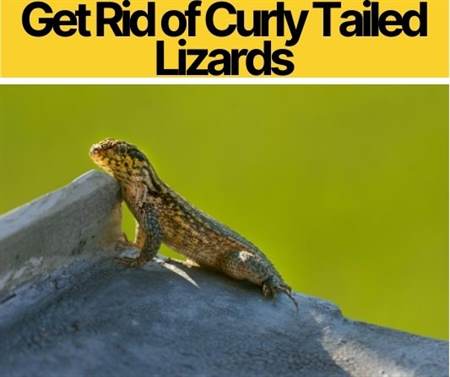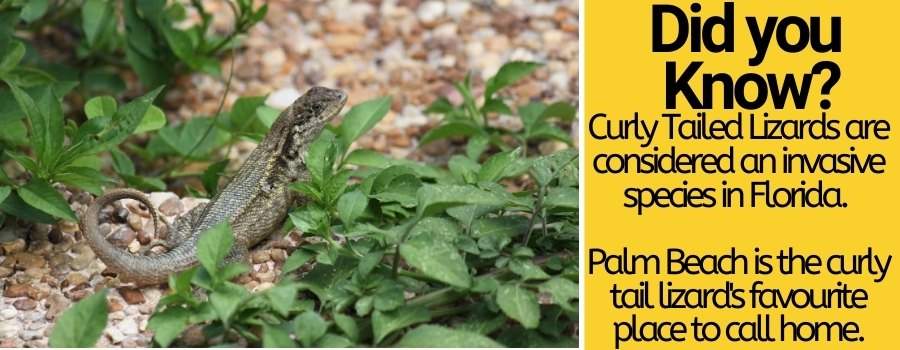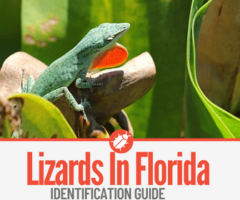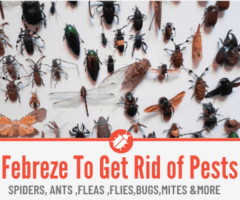 You might have spotted this little yellow reptile with black spots, bloated belly and obvious coiled tail roaming around your garden, pavement, or patio. After all, they seem to be everywhere, right?
You might have spotted this little yellow reptile with black spots, bloated belly and obvious coiled tail roaming around your garden, pavement, or patio. After all, they seem to be everywhere, right?
Since the fifties, these non-native critters have been quite a problem to control eating other local species and intruding into people’s homes.
Even if they are not dangerous, keep reading to learn how to get rid of these uninvited reptiles.
How To Eliminate & Get Rid Of Curly Tailed Lizards
Even if they are not poisonous to human beings or domestic animals and they are great to help control insect pests, this 3.5-inch lizard is not always a welcomed visitor. They are a little difficult to get rid off completely, but here are a couple of ideas to help keep that little intruder as far away as possible:
Moth Balls
These compact balls of pesticide are actually a wonderful remedy for Curly tailed lizards, snakes, and even frogs. Apparently, they dislike the smell of naphthalene or paradichlorobenzene, which is the main active ingredient. You can try to spread some of those around your house area. Just remember to keep them out of reach from kids and pets.
Eggs shells
This is a cheaper and less toxic idea that some locals swear by. Supposedly, lizards will avoid areas where eggshells can be found because it makes them believe that a larger predator, such as a snake or a chicken, can be around. The trick is to not wash them so they can smell the fresh shell, you can crush them and spread them around or place the entire halves around the garden and entrances.
Curly Tail Lizard Traps
Trapping a curly is the best way to get them out of your home and back into their natural habitat. There are a couple of commercial traps floating all over the Internet. Some people suggest mousetraps or sticky traps get rid of our critters here, but an excellent way could be to set up a trap, or even create your own lizard trap.
Here is how to make one:
- Grab an odorless shoebox (any cardboard box will do too) or a plastic/glass terrarium without the lid.
- Cover the top with cellophane and secure it with some clear tape. Now remember that curlies are around 3.5 in, so you want to cut a hole right in the middle big enough for your reptile to fit but not so much so it won’t escape once you capture it.
- Curly-tailed lizards prey mainly on beetles, ants, spiders, crickets, crabs, and snails, but their voracious appetite will make them feed on anything but it is not always good for their digestive system. Place some “food” inside the box to attract the lizard, try some insects, fruits, or even flowers to get their attention.
- You can also try to place a nice layer of sand and some rocks, remember curlies prefer these types of habitats.
- If you have spotted a curly before, place it close to the last time you spotted one… and now, just wait and come back regularly to check if the trap has done its job properly. Good luck!

Can you Effectively Eliminate Curly Tailed Lizards
As annoying and intrusive they can be, remember that they are wild animals that mean no actual harm. There is no proper way to eliminate them 100%, but you can try some methods mentioned above to keep them away.
Instead of killing them, try to set some traps to get them outside safely. If you are having a severe intruder invasion, call a pest control.
Catching Curly Tailed Lizards
Catching a curly is probably the trickiest but the best way to take them out of your homes. These northern reptiles are fast-moving and can climb with ease on any surface, but catching them requires a similar process that any other lizard–since they are not poisonous or require special handling. Here are is a step-by-step that can do this task a little easier and does not require using your hands.
- Corner the critter: The first step is to delimitate the chasing area as much as possible. If you are inside your home, close all doors and all possible escape routes. Outdoors, you can try to “chase” them to a more cornered area.
- Use Freezing Water: As you know, curlies are cold-blooded animals that need the environment’s temperature to control their own. Spraying them with freezing water will slow her down or make her paralyzed for a little while.
- Act out: If the curly froze or slowed down, now it is a good time to place a bucket over the creature and with cardboard or envelope, slide it under the bucket to secure the trap, and avoid a runaway.
Do Curly Tail Lizards Bite?
These little critters are known for having quite an attitude against humans, but they are not likely to be aggressive, attack or bite unless provoked or feeling threatened. However, male curlies can become very territorial and a bit more aggressive during mating season, which is from late fall to early spring.
What Repels Curly Tail Lizards?
- Coffee and tobacco: While this combination sounds like a morning routine to some, it is a known enemy to some insects and lizards. Tobacco is poisonous for lizards, while the potent smell of coffee is not something they enjoy like we do. Mix grounded coffee with some tobacco powder and sprinkle around.
- Garlic and Onion: These two pungent ingredients have an enzyme that lizards cannot tolerate, so making a juice of both ingredients and spraying it around might help repel them. It is not recommended to leave cloves or onion slices around because if you have domestic animals it can be bad for their health.
- Dried Chili And Pepper: If spicy condiments can make us sneeze, you can imagine the effect it has on a small critter. These ingredients have compounds (capsaicin and piperine) that irritate nerve endings, so you can use pepper, dried chili, or cayenne pepper on small porous bags just for the creatures to smell the powerful smell.
Are Curly-Tail Lizards Invasive
Yes, these northern creatures are considered an invasive species in Florida. What started as a pest-control project soon spread out around the state.
Nowadays these Lizards are found in eleven counties in Florida, and they continue to spread about a mile per year.
Palm Beach is the curly-tail lizard’s favorite place to call home.
The International Union for Conservation of Nature (IUCN) considers this lizard an intruder of least concern, which means they are not an important threat to native or species in danger like the Burmese python or the Cane Toads. While these lizards are inoffensive to humans, their omnivorous diet has become quite a problem for other native species, especially anoles, spiders, small crabs, and other native lizards.
As a fun fact, the hospitable and varied weather has made Florida home to over 500 non-native flora and fauna species.
Related Questions.
Where are curly tail lizards from
Curly lizards are native from Cuba, The Cayman Islands, the Bahamas, and other Caribbean Islands. It was around the forties when these curly tails ended up on the Sunshine State.
The first time curly-tailed lizards settled around Florida was reported in 1935, when some of these creatures escaped from a local zoo, but the proper theory states that the invasion started after a pest-control project failed. In 1940, a man released 40 curly tail lizards on his farm to help get rid of the sugar-cane bugs, but a couple of years later, the reptiles escaped and spread all around Palm Beach.
Where Do Curly Tail Lizards Live
Curly lizards are pretty adaptable creatures. While they prefer sunny, sandy, and areas surrounded by trees, they have adapted pretty well to our modern human life. While these lizards are known climbers and arboreal creatures, they prefer to stay on the ground, wherever they can find firm surfaces.
In their natural habitat, curlies live under rocks, logs, or find shelter buried in the sand, but in urban areas, they prefer surfaces that imitate a rocky or sandy natural environments such as parking lots, sidewalks, parks, or gardens.
This lizard is cold-blooded, like most reptiles are, which means their body temperature depends on the environment. For this reason, curly lizards need to spend most of their active daytime in open and sunny areas where their bodies can warm up from sunlight.
Where Do Curly Tailed Lizards Usually Hide
These reptiles are active only during the day, and for most nights they will hide away from predators such as birds, other reptiles, and some rodents under rocks, burrows, or sand if it is available.
While these creatures are most likely to stay outside, in your porch, beneath a pile of bricks or under some rocks but they will join your house if the opportunity (and food) is available. This lizard is famous for its insatiable and opportunistic appetite, so inside your home you will probably find them wherever it’s dry and some food is available–yes, they will feed on anything, including human food.






